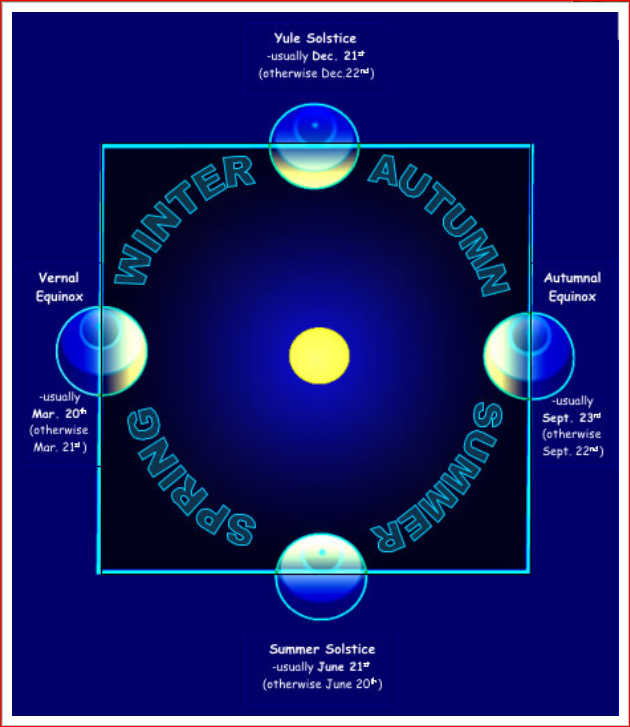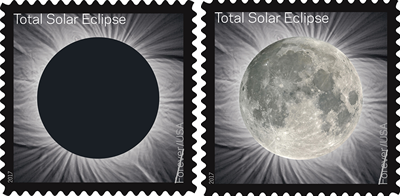
This diagram shows the position of the Earth, in relation to the Sun, at the time of the Summer Solstice, as well as the other solstice and equinoxes of the year.
(Graphic Source: ©1999, Eric G. Canali, former Floor Manager of Pittsburgh's original Buhl Planetarium and Institute of Popular Science and Founder of the South Hills Backyard Astronomers amateur astronomy club; permission granted for only non-profit use with credit to author.)
By Glenn A. Walsh
Reporting for SpaceWatchtower
This year in North America, the Summer
Solstice occurs both on Tuesday and Wednesday, depending on which
time zone is being considered. On Tuesday, the Summer Solstice
is being celebrated in Wyoming, by the U.S. Post Office, by the
unveiling of a very special postage stamp to commemorate the Great
American Solar Eclipse which will occur on August 21. This unveiling
will occur following a rather unique, Stonehenge-like Solstice event! And on Wednesday, NASA will hold a news conference, which can be seen on NASA-TV (including on the Internet), regarding the Great American Solar Eclipse.
Summer Solstice 2017
For 2017, the season of Summer begins
in Earth's Northern Hemisphere (and the season of Winter begins in
the Southern Hemisphere) at the moment of the June Solstice:
Wednesday Morning, 2017 June 21 at 12:24 a.m. Eastern Daylight Saving
Time (EDT) / 4:24 Coordinated Universal Time (UTC).
Now in North America, the Summer
Solstice occurs early Wednesday morning only in the Eastern and
Atlantic Time Zones, according to Daylight Saving Time. Elsewhere in
North America, the Summer Solstice occurs late Tuesday evening.
In etymology, the word solstice
comes from the Latin terms sol (Sun) and sistere (to
stand still). In ancient times, astronomers / astrologers / priests
recognized that on one day of the year (in the Northern Hemisphere,
near the day we now call June 21), the Sun would appear to reach its
highest point in the sky for the year. The motion of the Sun's
apparent path in the sky (what is known astronomically, today, as the
Sun's declination) would cease on this day, before appearing
to reverse direction.
Today, we know that, while the Sun does
have motions, it is actually the motion of the Earth tilted on its
axis 23.43715 degrees / 23 degrees 26 minutes 13.7 seconds away from
the plane of the ecliptic (Earth's orbital plane around the Sun),
while revolving around the Sun, that causes the Earth's seasons.
Hence, as the Earth arrives at the point in its orbit around the Sun,
when the north polar axis is most directly inclined toward the Sun,
this marks the Summer Solstice in the Northern Hemisphere and the
Winter Solstice in the Southern Hemisphere.
Alternately, the Winter Solstice in the
Northern Hemisphere occurs when the Earth reaches the point in its
orbit when the North Pole is most directly inclined away from the
Sun. And, conversely, at this time Summer begins in the planet's
Southern Hemisphere.
Although the Summer months in the
Northern Hemisphere are known for the year's warmest weather, the
Earth is actually at the point in its orbit farthest from the Sun
(astronomically known as the point of aphelion) around July 5;
the Earth's closest approach to the Sun (perihelion) each year
is around January 2. Solar radiation, and hence the heat from the
Sun, depends on the length of daylight and the angle of the Sun above
the horizon. The tilt of the planet's axis toward the Sun determines
the additional and more direct solar radiation received by a planet's
Northern or Southern Hemisphere, and hence, the warmer season of the
respective hemisphere.
The Vernal Equinox, when the season of
Spring begins in the Northern Hemisphere (and the season of Autumn
begins in the Southern Hemisphere), occurs between the Winter and
Summer Solstices when the Earth reaches the point in its orbit around
the Sun when the Earth's axis is inclined neither toward nor away
from the Sun. Likewise, when the Earth reaches the point in its orbit
around the Sun, between the Summer and Winter Solstices, when the
Earth's axis is inclined neither toward nor away from the Sun, this
is known as the Autumnal Equinox (beginning of Fall or Autumn) in the
Northern Hemisphere; at this time Spring begins in the Southern
Hemisphere. And, half-way between the beginning points of each season
are Cross-Quarter Days, each related to traditional holidays:
Groundhog Day (February 2), May Day (May 1), Lammas Day
(traditionally, the first harvest festival of the year on August 1),
and Halloween (October 31).
In ancient times, the Summer Solstice
was known as Midsummer Day, in early calendars observed around June
24. Such early European celebrations were pre-Christian in origin.
Many will associate this ancient holiday with the famous William
Shakespeare play, “A Midsummer Night's Dream.” Some speculate
that the play was written for the Queen of England, to celebrate the
Feast Day of Saint John.
As with the Roman Catholic Church's
decision to Christianize the pagan Winter Solstice festivals with the
introduction of Christmas Day on December 25, the Church began to
associate the Midsummer festivals with the Nativity of Saint John the
Baptist on June 24. In the Bible, the Gospel of Saint Luke implies
that John was born six months before the birth of Jesus, although no
specific birth dates are given.
Unveiling of Great
American Solar Eclipse Postage Stamp (#EclipseStamps)

On June 20, the U.S. Postal Service
issues a unique postage stamp (Forever Stamp) marking the Great
American Solar Eclipse (which will cross the continental United
States from Oregon to South Carolina on August 21) at the University
of Wyoming Art Museum. A first-of-a-kind stamp, the heat from the
touch of a finger transforms the eclipsed Moon into the image of the
Moon!
The postage stamp unveiling will occur
at the Art Museum on the campus of the University of Wyoming (UW) in
Laramie, Wyoming at 1:30 p.m. Mountain Daylight Saving Time (MDT) /
3:30 p.m. EDT / 19:30 UTC. The Post Office asks the public to
share this news on Social Media, using the hash-tag #EclipseStamps.
The reason the U.S. Postal Service
chose this particular Art Museum for the postage stamp unveiling is due to a rather unique,
Stonehenge-like event that occurs each year at this museum, around
the time of the Summer Solstice. An hour and a-half before the
unveiling, on that Tuesday at 12:00 Noon MDT / 2:00 p.m. EDT / 18:00
UTC, visitors can see a single beam of sunlight shining on a Silver
Dollar embedded in the floor of the UW Art Museum's Rotunda Gallery.
Visitors are encouraged to arrive at the museum by 11:30 a.m. MDT /
1:30 p.m. EDT / 17:30 UTC, to view this rather unique architectural
feature.
Countdown to the Great American Solar Eclipse
On the day of the Summer Solstice, Wednesday, June 21, 1:00 to 3:30 p.m. EDT / 17:00 to 19:30 UTC, NASA will hold a news conference regarding the Great American Solar Eclipse, which will be exactly two months from June 21. During the news conference, which can be seen on NASA-TV on cable television or streamed on the Internet, people can learn about:
Countdown to the Great American Solar Eclipse
On the day of the Summer Solstice, Wednesday, June 21, 1:00 to 3:30 p.m. EDT / 17:00 to 19:30 UTC, NASA will hold a news conference regarding the Great American Solar Eclipse, which will be exactly two months from June 21. During the news conference, which can be seen on NASA-TV on cable television or streamed on the Internet, people can learn about:
- How to experience the August 2017 eclipse through the eyes of NASA
- Views from different areas of the country and how to prepare
- Safe eclipse viewing practices
- What causes an eclipse and why you should care
- How to participate in events around the country
- The unique research opportunities to study our Earth, moon and the sun
Internet Links to Additional Information ---
Special U.S. Postage Stamps Commemorating the Great American Solar Eclipse on August 21:
Link >>> https://about.usps.com/news/national-releases/2017/pr17_020.htm
Great American Solar Eclipse (Oregon to South Carolina) on August 21:
Link 1 >>> https://eclipse.gsfc.nasa.gov/SEgoogle/SEgoogle2001/SE2017Aug21Tgoogle.html
Link 2 >>> https://eclipse2017.nasa.gov/
Link 3 >>> https://en.wikipedia.org/wiki/Solar_eclipse_of_August_21,_2017
Safe Public Viewing Event of the August 21 Great American Solar Eclipse in South Suburban Pittsburgh:
Link >>> http://buhlplanetarium.tripod.com/archivenews/releases/poster-flyer/2017SolarEclipse-Flyer.htm
Solar Eclipse / Eclipse of the Sun - Tips for Safe Viewing:
Link >>> http://andrewcarnegie.tripod.com/solflyer2.htm
More on the Summer Solstice -
Link 1 >>> http://scienceworld.wolfram.com/astronomy/SummerSolstice.html
Link 2 >>> http://en.wikipedia.org/wiki/Summer_solstice
More on the Season of Summer: Link >>> http://en.wikipedia.org/wiki/Summer
More on the history of Midsummer: Link >>> http://en.wikipedia.org/wiki/Midsummer
Summer "Solstice Day" Annual Free-of-Charge Day, 1985 to 1991, at Pittsburgh's original Buhl Planetarium and Institute of Popular Science (a.k.a. Buhl Science Center):
Link >>> http://spacewatchtower.blogspot.com/2015/06/snowballs-on-first-day-of-summer.html
2017 August 21 -
Public observing session for the Great American Solar Eclipse, co-sponsored by
Friends of the Zeiss and the Mount Lebanon Public Library. The Mount Lebanon Public
Library estimated public attendance at 300. Members of Friends of the Zeiss
participating in this event were Glenn A. Walsh, Lynne S. Walsh, James McKee, and
Josie Dougherty(eighth-grade student who had just attended NASA's Space Camp in
Huntsville, Alabama).
Link >>> http://buhlplanetarium.tripod.com/fotz/history.html#GASE
Safe Public Viewing of the Great American Solar Eclipse
Monday, August 21, 2017
Mt. Lebanon Public Library, South Suburban Pittsburgh
More Info: Link >>> http://buhlplanetarium.tripod.com/archivenews/releases/poster-flyer/2017SolarEclipse-Flyer.htm
Special Thanks:
* John Sibenac, producer of bookmarkers from postage stamps.
* Eric G. Canali, former Floor Manager of Pittsburgh's original Buhl Planetarium and Institute of Popular Science and Founder of the South Hills Backyard Astronomers amateur astronomy club.
Source: Glenn A. Walsh Reporting for SpaceWatchtower, a project of Friends of the Zeiss.
2017 June 19.
Like This Post? - Please Share!
More Astronomy & Science News - SpaceWatchtower Twitter Feed:
Link >>> https://twitter.com/spacewatchtower
Astronomy & Science Links: Link >>> http://buhlplanetarium.tripod.com/#sciencelinks
Want to receive SpaceWatchtower blog posts in your in-box ?
Send request to < spacewatchtower@planetarium.cc >.
gaw
Glenn A. Walsh, Project Director, Friends of the Zeiss: < http://buhlplanetarium.tripod.com/fotz/ >
& SpaceWatchtower Editor / Author: < http://buhlplanetarium2.tripod.com/weblog/spacewatchtower/gaw/ >
Electronic Mail - < gawalsh@planetarium.cc >
Astronomy Links: < http://buhlplanetarium.tripod.com/#astrolinks >
Science Links: < http://buhlplanetarium.tripod.com/#sciencelinks >
SpaceWatchtower Twitter News Feed: < https://twitter.com/spacewatchtower >
SpaceWatchtower Blog: < http://spacewatchtower.blogspot.com/ >
LibraryWatchtower Blog: < http://librarywatchtower.blogspot.com >
TransportWatchtower Blog: < http://transportwatchtower.blogspot.com >
South Hills Backyard Astronomers Blog: < http://shbastronomers.blogspot.com/ >
Barnestormin Blog: Writing, Essays, Pgh. News, etc.: < http://www.barnestormin.blogspot.com/ >
Author of History Web Sites on the Internet --
* Buhl Planetarium, Pittsburgh:
< http://www.planetarium.
* Adler Planetarium, Chicago:
< http://adlerplanetarium.
* Astronomer, Educator, Optician John A. Brashear:
< http://johnbrashear.tripod.com >
* Andrew Carnegie & Carnegie Libraries:
< http://www.andrewcarnegie.
* Civil War Museum of Andrew Carnegie Free Library:
< http://garespypost.tripod.com >
* Duquesne Incline cable-car railway, Pittsburgh:
< http://inclinedplane.tripod.
* Public Transit:
< http://andrewcarnegie2.tripod.
